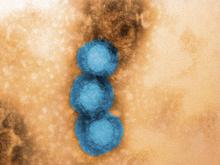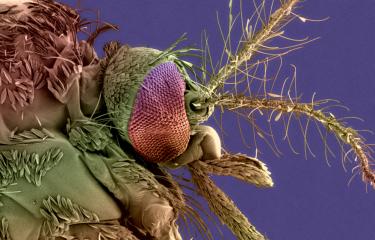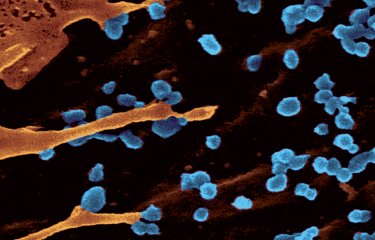Teams from the Institut Pasteur have shown that a mutation of the Chikungunya virus that facilitates its penetration into the vector mosquito could explain the epidemic explosion recorded in the Indian Ocean at the beginning of 2006. Further, the teams have provided important data suggesting the possibility of a vertical transmission of the virus from the infected female to its descendents. Their results have been published in PLoS ONE (1).
Meanwhile, the same researchers have evaluated the ability of the mosquitoes present in the South of France to transmit the virus (2).
Press release
Paris, november 14, 2007
From the Indian Ocean...

virus du chikungunya (en bleu)Starting in spring 2006, researchers from the Institut Pasteur revealed a particular mutation of the Chikungunya virus (see our 23 May 2006 press release). The viruses carrying this mutation spread during the epidemic, supplanting the nonmutated viruses. This mutation was localised at a viral protein known to be involved in attaching the virus to the mosquito’s digestive epithelium, the path the virus uses to enter this vector. Researchers raised the hypothesis that this mutation could facilitate the crossing of the "intestinal barrier" in the vector mosquito, the Aedes albopictus, more familiarly called the "Asian tiger mosquito".
To evaluate this hypothesis, experiments were conducted at the Institut Pasteur on mosquitoes collected in the field in March 2006 by Anna-Bella Failloux (Molecular Genetics of Bunyaviruses Unit) and Marie Vazeille (Virology Department), in collaboration with several other teams from the institute, as well as the Regional Health and Social Affairs Department for Réunion, and the Institut de Recherche pour le Développement (Research for Development Institute, IRD).
These experiments consisted in evaluating the "vector competence" of mosquitoes from Réunion and Mayotte with regard to the mutant strain and to a viral strain isolated in June 2005, prior to the epidemic peak. The researchers thereby observed that the Aedes albopictus present on Réunion transmitted the mutant virus twice as well as the nonmutant virus in laboratory conditions. This is explained by the mutant virus’ better ability to pass through the mosquito’s digestive tract, as the researchers demonstrated.
"The mutant virus that emerged some time in 2005 therefore seems more effective in infecting the vector than the nonmutated virus it replaced. The differences observed in the laboratory between the two viral strains could partly explain the explosive character of the epidemic", explained Failloux.
Moreover, this first study has also made it possible to show that the Chikungunya virus, whichever viral strain is considered, affects the salivary glands of Aedes albopictus in two days. "This is extremely fast compared to other virus-mosquito pairs", Failloux stressed. "This mosquito obviously does not need to survive long in order to transmit the Chikungunya virus. Vector control must therefore be started quickly during an epidemic, as soon as the first cases are detected."
Other results: the virus, whichever strain is analysed, is found in the eggs of female mosquitoes. "They are thus potentially capable of transmitting the virus to their descendents", Failloux added. "But be careful: this does not mean that the descendents have an infectious potential. We must verify whether a sufficient concentration of the virus is found in the salivary glands of adult female descendents to the point that they are capable of infecting humans." The experiments in progress should answer this vertical transmission question, which is crucial for directing vector control.
...to the South of France
Moustique Aedes albopictus, vecteur du virus chikungunya /// copyright Institut PasteurAnother study conducted by Vazeille and Failloux, in collaboration with the EID Méditerranée (Mediterranean Interdepartmental Mosquito Control Agreement), attempted to test the vector competence of mosquitoes present in the South of France, as part of the French dengue-Chikungunya dispersal control plan.
This is an especially important evaluation in light of the Chikungunya epidemic that occurred in Italy last year, the first of its kind in Europe.
Aedes albopictus is present in the Alpes-Maritimes and Var departments, and was found in Corsica in 2006. The vector competence of this mosquito—as well as of other species of mosquitoes collected in the South of France—with regard to the Chikungunya virus currently present in the Indian Ocean was measured in the laboratory. "We showed that the populations of Aedes albopictus present in the South of France can act as a vector to the Chikungunya virus. However, other parameters, such as the density of mosquitoes, are essential elements for triggering an epidemic", explained Failloux. "The presence of Aedes albopictus in tourist areas in the South of France and Corsica must then be considered a potential threat for the emergence of the Chikungunya virus in these regions, hence the intensive surveillance set up by the EID Méditerranée", she concluded.
Sources
> Press release from 23 May 2006:
Read the press release
> (1)"Two chikungunya isolates from the outbreak of La Réunion (Indian Ocean) exhibit different patterns of infection in the mosquito, Aedes albopictus": PLoS ONE, 2007
Marie Vazeille1, Sara Moutailler2, Daniel Coudrier2, Claudine Rousseaux3, Huot Khun4, Michel Huerre4, Julien Thiria5, Jean-Sébastien Dehecq5, Didier Fontenille6, Isabelle Schuffenecker7, Philippe Desprès8, and Anna-Bella Failloux2
1. Virology Department (Chikungunya programme), Institut Pasteur, Paris
2. Molecular Genetics of Bunyaviruses Unit, Institut Pasteur, Paris
3. Urgent Response to Biological Threats, Institut Pasteur, Paris
4. Histotechnology and Pathology Unit, Institut Pasteur, Paris
5. Health and Social Affairs Department for Réunion, Saint-Denis, Réunion
6. IRD, Montpellier
7. National Reference Centre for Arboviruses and Haemorrhagic Fever Viruses, Biology of Emerging Viral Infections Unit, Institut Pasteur, Lyon
8. Flavivirus-Host Molecular Interactions Unit, Institut Pasteur, Paris
> (2) “Chikungunya : a risk for Mediterranean countries ?” : Acta Tropica (2007 - doi:10.1016/j.actatropica.2007.09.009). Vazeille M. et al.
Contact press
Corinne Jamma - 01 40 61 33 41 - cjamma@pasteur.fr
or Nadine Peyrolo - npeyrolo@pasteur.fr




